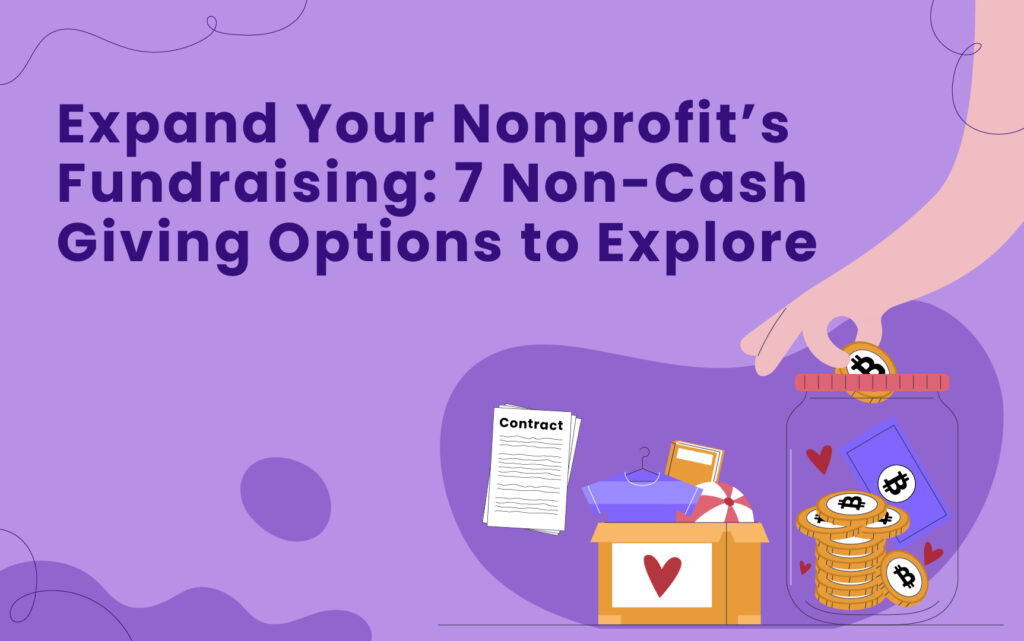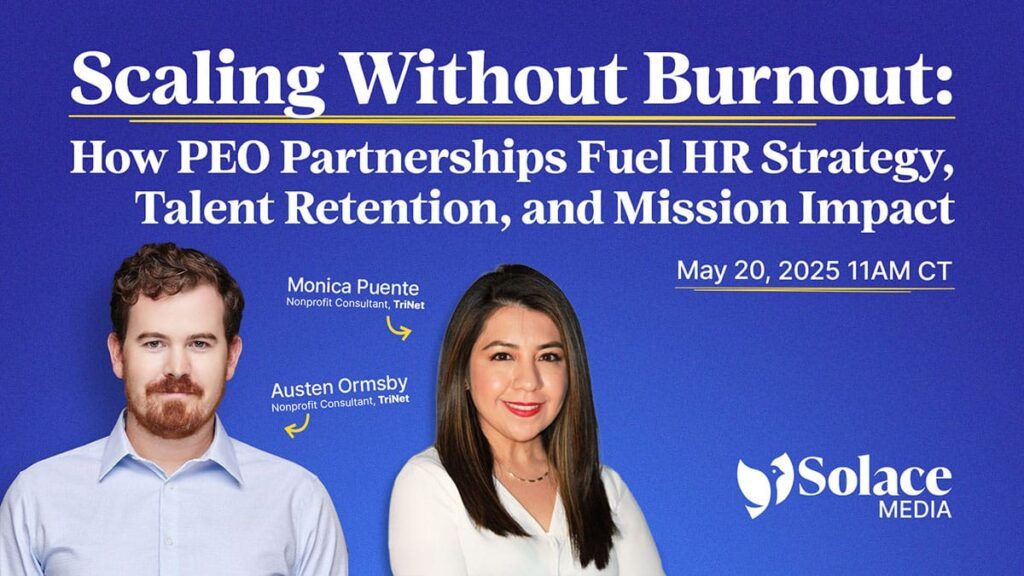As a nonprofit leader, you’re always looking for ways to fund your mission more effectively. You can sometimes feel you’ve tapped out your donor base or exhausted your usual strategies. But what if I told you there’s a vast pool of potential support that many nonprofits aren’t fully tapping into?
Here’s a fact that surprises most people:
Over 90% of wealth in the US is not held in cash.
Let that sink in for a moment.
If your nonprofit focuses solely on cash donations, you might be unintentionally limiting your donors’ ability to support causes they care about. But if you offer or expand non-cash giving options, you open up new avenues for supporters to give, increasing the opportunity for generosity and impact.
Keep reading as we explore seven non-cash giving options that could open new doors for your nonprofit.

1. Gifts of Stock: Unlocking Portfolio-Based Philanthropy
Gifts of stock allow donors to contribute shares of publicly traded companies directly to your nonprofit. Instead of selling the stock and donating the proceeds, donors transfer ownership of the shares to your organization. If you’re not already accepting stock donations, this could be a game-changer. For donors with investment portfolios, giving appreciated stocks can be far more advantageous than giving cash.
How your nonprofit can benefit:
- Potentially receive larger gifts as donors avoid capital gains taxes
- Attract high-net-worth donors who may prefer this giving method
- Diversify your nonprofit’s investment portfolio OR can liquidate into cash upon receipt
How donors benefit:
- Avoid capital gains taxes on appreciated stocks
- Receive a tax deduction for the full fair market value of the stock
- Make a larger gift than they might be able to with cash
Implementation tips:
- Partner with a brokerage firm to set up a stock transfer account
- Train your team on the process – it’s simpler than you might think!
- Create a clear “How to Donate Stock” guide on your website

2. Donor-Advised Funds (DAFs): Flexible Giving for Strategic Donors
A Donor-Advised Fund is like a charitable savings account. Donors contribute to the fund and receive an immediate tax deduction, then recommend grants from the fund to their chosen charities over time. DAFs are growing in popularity. If you’re not set up to receive DAF gifts, you might be missing out on a significant funding source.
How your nonprofit can benefit:
- Tap into a rapidly growing giving vehicle
- Attract donors who prefer to plan their giving strategically
- Potential for larger, more consistent gifts over time
How donors benefit:
- Immediate tax deduction when they contribute to their DAF
- Ability to grow their charitable funds tax-free
- Flexibility to support multiple charities over time
Implementation tips:
- Ensure you’re set up to receive DAF gifts (most sponsors make this easy)
- Educate your team about DAFs and how to discuss them with donors
- Create materials explaining DAF benefits for your donors

3. Qualified Charitable Distributions (QCDs): Appealing to Retirement-Age Donors
Qualified Charitable Distributions allow donors aged 70½ or older to donate up to $100,000 annually directly from their Individual Retirement Accounts (IRAs) to eligible charities without counting the distributions as taxable income. This can be a tax-efficient way for them to support your cause while satisfying Required Minimum Distributions (RMDs). Note: make sure to check current tax filing requirements on the IRS website for the most updated age/limit requirements.
How your nonprofit can benefit:
- Attract gifts from donors with significant retirement assets
- Offer a tax-efficient giving option for older supporters
- Potentially receive larger gifts that might otherwise go to taxes
How donors benefit:
- Satisfy RMD requirements without increasing taxable income
- Reduce their overall tax burden
- Support their favorite causes in a tax-efficient manner
Implementation tips:
- Reach out to your retirement-age donors about this option – many don’t know about it!
- Create a simple QCD guide for your website and newsletters
- Partner with local financial advisors to spread the word

4. Planned Giving: Securing Your Nonprofit’s Future
Planned giving, also known as legacy giving, involves donors making arrangements for larger gifts to be given to your nonprofit in the future, often as part of their estate planning. These gifts can take various forms, such as bequests in wills, charitable trusts, or life insurance policies. If you don’t have a planned giving program, you’re missing out on potentially transformative gifts. These often end up being the largest donations a supporter ever makes.
How your nonprofit can benefit:
- Secure significant future funding for your organization
- Deepen relationships with your most committed supporters
- Create a legacy program that inspires major gifts
How donors benefit:
- Create a lasting legacy that aligns with their values
- Potential tax benefits for their estate
- Ability to make a larger gift than they might be able to during their lifetime
Implementation tips:
- Start simple with bequest programs, then expand to other options
- Train your team on having legacy conversations – focus on donor values and long-term impact
- Create materials that tell stories of impact through planned gifts

5. Cryptocurrency: Embracing New Forms of Wealth
Cryptocurrency donations involve accepting digital currencies like Bitcoin or Ethereum as charitable contributions. These digital assets can be converted to traditional currency or held as investments. If you’re not set up to accept crypto donations, you might be missing out on a growing donor segment.
How your nonprofit can benefit:
- Attract tech-savvy, younger donors
- Potentially receive larger gifts due to crypto’s appreciation
- Position your nonprofit as innovative and forward-thinking
How donors benefit:
- Avoid capital gains taxes on appreciated cryptocurrency
- Receive a tax deduction for the full fair market value of the donated crypto
- Support causes using a new form of wealth they may not have considered for charitable giving
Implementation tips:
- Partner with a reputable crypto payment processor for secure transactions
- Educate your team on crypto basics – you don’t need to be experts, just conversant
- Create a dedicated “Donate with Crypto” page on your website

6. Royalties: Tapping into Intellectual Property
Royalty donations involve supporters assigning the rights to their intellectual property to your nonprofit. This could include royalties from books, music, patents, or other creative works. When someone donates royalties, they’re essentially giving your organization the right to receive future income generated by their intellectual property. If you haven’t considered accepting royalty donations, you might be missing out on a unique and potentially significant source of ongoing funding.
How your nonprofit can benefit:
- Create a potentially long-term, passive income stream
- Tap into the success of creative works or inventions
- Diversify your funding sources with a unique revenue stream
- Potentially receive increasing donations if the intellectual property gains popularity over time
How donors benefit:
- Support their chosen cause through their creative or innovative work
- Potential tax benefits, as they may be able to deduct the fair market value of the royalty rights
- Create a lasting legacy tied to their intellectual property
- Simplify their giving by setting up an ongoing donation that doesn’t require repeated action
Implementation tips:
- Consult with legal experts to ensure proper handling of intellectual property rights
- Develop clear agreements that outline the terms of the royalty donation
- Create materials explaining this unique giving option to potential donors
- Consider partnering with local authors, musicians, or inventors to explore this option
- Educate your team on how to discuss and process royalty donations

7. Endowment Funds: Building Long-Term Financial Stability
An endowment fund is a permanent, self-sustaining source of funding. Endowments are typically structured so that the principal amount is kept intact while the investment income is available for use, or part of the principal is released each year, according to your nonprofit’s spending policy. This can provide a reliable source of income to support your organization’s mission in perpetuity. If you haven’t considered establishing an endowment fund, you might be missing out on a powerful tool for long-term financial stability.
How your nonprofit can benefit:
- Create a stable, long-term source of income
- Enhance your organization’s prestige and perceived financial stability
- Provide a cushion against economic downturns or fluctuations in other funding sources
- Allow for better long-term planning and potentially more ambitious projects
How donors benefit:
- Create a lasting legacy that supports their favorite cause indefinitely
- Potential tax benefits, especially for larger gifts
- Satisfaction of contributing to the long-term sustainability of an organization they care about
- Opportunity to have a fund named after them or a loved one
Implementation tips:
- Develop clear policies for how the endowment will be managed and used
- Partner with a reputable financial institution or community foundation to manage the funds
- Create compelling materials explaining the long-term impact of endowment gifts
- Consider starting with a “quasi-endowment” that your board can choose to use if needed
- Educate your board and staff about the importance and mechanics of endowment funds
Take Your Non-Cash Giving to the Next Level
As we’ve explored, non-cash giving options open up a world of possibilities for your nonprofit. They allow you to tap into the 90% of wealth not held in cash, offering your donors flexible and often tax-advantageous ways to support your mission.
But knowing about these options is just the first step. Implementing them effectively requires knowledge, planning, and sometimes specialized expertise. That’s why we are thrilled to invite you to our upcoming webinar, presented in partnership with Carnegie Investment Counsel:

In this webinar, we’ll dive deep into one of the most popular and potentially lucrative non-cash giving options: gifts of stock. You’ll learn:
- The importance of prioritizing stock donations for your nonprofit
- How to simplify the stock donation process and remove obstacles for donors
- Effective techniques to incorporate stock donations into your fundraising and marketing strategy
By embracing non-cash giving options, you’re not just diversifying your funding streams – you’re opening doors for supporters to make a difference in ways that work best for them. Every new giving method you add to your toolkit is another opportunity for generosity. Here’s to growing your impact and empowering your donors!


